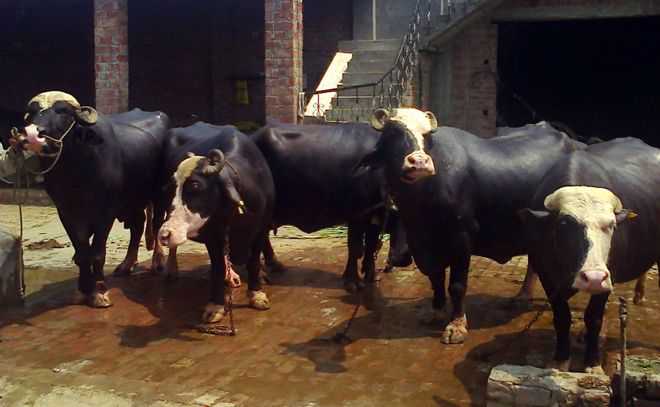
.
Barely in my early teens, I set out along with a farm worker about 45 years ago to sell a muscled male buffalo calf. We hoped that it would fetch us at least Rs 300. On the outskirts of our village, an animal trader offered us just Rs 90. By the time we reached the cattle mandi in Samana, we were offered Rs 400; the deal was struck. I thought that this calf would be used for draft purposes, which was a common practice during those days. Little did I realise that it could have been a precious breeding bull, but it was beyond my comprehension that the calf could also be slaughtered for meat.
Following farm mechanisation in the sixties, draft animals increasingly became redundant, and the major focus of animal production has been to enhance milk yield. To achieve this objective, cattle breeding scientists followed a short cut called cross-breeding: importing exotic cattle (cow) semen from Europe, North America, Israel and Australia and upgrading cows of local breeds. The well-known procedure of ‘selective breeding’ for improving the productivity of local cattle and buffalo remained ignored. Indigenous breeds of cows and buffaloes have been here for years and are resistant to many diseases and tropical weather conditions.
The two high-yield breeds of cows that Indian scientists claim to have developed — Karan Swiss and Frieswal — are the outcome of crossing an exotic breed with a local breed of cows. It has now become a fad to cross Sahiwal cows of Punjab with Gir cows from Gujarat. This will lead to a loss of the identity of pure dairy cattle breeds of Punjab. Similarly, the pure Murrah buffalo breed has been spoiled through crossing with Jafarabadi buffalo from Gujarat. It is now very hard to gather the gene pool of pure local breeds of cattle and buffaloes. Lately, however, with increasing realisation of the merits of indigenous breeds, some dairy farmers, private agencies and NGOs are working hard to revive pure local breeds of cattle, and to some extent buffaloes, in Punjab.
One can corroborate the high incidence of reproductive diseases in high-yield cross-bred cows even on organised farms. There is hardly any dairy farm that is free from reproductive infections such as brucellosis, campylobacter and herpes (cows and buffaloes have common diseases). This is an alarming situation and has already affected our export of meat, milk, hides and germplasm. Infectious diseases of exotic origin have also invaded our production systems, such as bovine viral diarrhoea. Our biosecurity measures are inadequate, making our dairy animals prone to such diseases. During a visit to a centre in Ontario (Canada) along with a state government delegation, we were allowed access to cow bulls only through glass partitioning. That is the kind of biosecurity needed here too.
Farmers of Punjab have worked hard in dairy development. However, their produce is not fetching adequate price, thus making dairy farming an unlucrative business. The other day, during a TV discussion, a dairy farmer rued that a bottle of water was costlier than a litre of cross-bred cow milk. High concentration of pesticides/insecticides from soil and water (hence, fodder) are adding to his misery as many milk-processing agencies do not accept milk with residues of pesticides/insecticides and antibiotics. The bitter truth is that even mother’s (human) milk contain insecticides or pesticides.
The bovine industry cannot forge ahead merely on the basis of milk production. The focus of dairy development should shift to the buffalo. It is obvious why stray animals include cattle, not buffaloes. The buffalo can be slaughtered for meat. There is a great demand for buffalo meat in foreign countries. Buffaloes being slaughtered presently are mainly unproductive or spent animals, and not specifically reared for meat, as is the case of beef animals abroad.
Murrah and Nili Ravi are milch breeds of buffalo in Punjab and Haryana. Some areas in Haryana (Rohtak) and Punjab (Ferozepur) have excellent Murrah buffaloes. Similarly, the districts of Punjab adjoining Pakistan have very good Nili Ravi buffaloes. Some farmers claim that the milk yield of their buffaloes may be as high as 3,000 litres in a lactation of 305 days.
The so-called ‘elite’ buffalo bulls, such as Yuvraj, are being used for commercial semen production. However, without proper pedigree workout, the use of such bulls may be a futile exercise in improving their progeny. Scientists from the two veterinary universities of the region (Hisar and Ludhiana) should come up with a policy for the development of the buffalo in the region. The Animal Husbandry Departments of these states should make concerted efforts to build on the pure indigenous breeds of buffaloes. Unlike cross-breeding, the improvement of an indigenous breed is a Herculean task. Years of dedicated labour and suitable policy support will be required.
Punjab has about 50 lakh buffaloes. Ludhiana alone has around 5 lakh of them, including those in the dairy complexes at Haibowal and Tajpur road. An estimated minimum number of buffalo calves born per year in theses dairy complexes could run into quite a few thousands. Taking into account the other dairy complexes and villages, the number of buffalo calves born annually in Punjab could easily touch a figure of 1 lakh or more. A majority of the calves born in the complexes die and only skin from their cadavers is used. These buffalo calves can be a game-changer for dairy farmers. The calves can be weaned/isolated immediately after calving into a hygienic facility and allowed to fatten into excellent meat beasts. The state government and the veterinary university should take steps to harness this wasted treasure.
The state government has established a buffalo centre in Tarn Taran district. It should also establish a ‘centre for meat buffalo’ with adjoining facility for slaughtering and processing. Certain private agencies/firms are already working on raising, procuring and processing buffalo calves from farmers. The veterinary university should be sanctioned a research grant for developing a ‘meat-type’ breed of buffalo and for establishing procedures and protocols for fattening of buffalo calves. This can prove to be a boon for improving milch breeds of buffaloes as well. The buffalo meat industry can grow faster than expected and fetch higher foreign exchange.
Animal husbandry is being projected as a viable alternative to traditional agriculture. Several limitations, however, restrict the growth of buffalo solely as a milch animal. Milking machines for buffaloes are still under development, and the labour availability for dairy farm operations is becoming increasingly difficult. The dairy complexes suffer from unhygienic conditions; a wide variety of animal and zoonotic diseases is prevalent. Hygiene, management and feeding procedures and protocols are inadequate. Dairy farm workers in large numbers test positive for zoonotic diseases, including bovine brucellosis and tuberculosis. It’s time the government, scientists and farmers think about innovative measures, including raising buffaloes for meat, to enhance the income of the farming community.
State-wise buffalo population (% share):
28.17 UP
11.94 Rajasthan
9.77 AP
9.55 Gujarat
7.53 MP
6.96 Bihar
5.6 Haryana
5.15 Maharasthra4.75 Punjab
3.19 K’taka
7.38 Other states
— Professor, Guru Angad Dev Veterinary and Animal Sciences University (GADVASU), Ludhiana



























